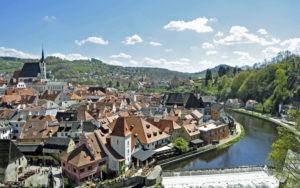
Town of Český Krumlov (Photo by Don Knebel)
In about 1250 A.D. a Czech noble family named “Krumlov” erected a Gothic castle on a bluff above a horseshoe bend in the Vtlava River, a trade route that also passed through Prague. A town called “Český Krumlov” developed below the castle. In 1302, the town came under the control of the Rosenbergs, an important Czech family known for supporting arts and culture. The Rosenbergs made Český Krumlov their primary residence, turning the castle into a Renaissance palace. The town became known for its breweries, markets and festivals. To accommodate the growing population, the Rosenbergs built a magnificent church honoring St. Vitus near the center of town. The town eventually passed to the Eggenberg family, which added a Baroque theatre to an enlarged castle.
By the beginning of the twentieth century, Český Krumlov had a population of about 9,000 people and its castle had been abandoned. After being passed back and forth during the periods of World Wars I and II, the town eventually came under the control of Czechoslovakia, whose Communist government largely ignored the town, saving its decaying buildings from being razed. After the “Velvet Revolution” in 1989, Czechoslovakia made restoring Český Krumlov a priority. In 1992, the town was declared a UNESCO World Heritage site, assuring the restoration’s authenticity. Today’s visitors walk along winding cobblestone streets lined with shops, many selling Bohemian glass, and more than 80 charming restaurants and bars. The castle, the second largest in the Czech Republic, is the most popular attraction, featuring one of the few theatres in Europe still using eighteenth century sets and equipment. For an enjoyable trip backward in time, Český Krumlov is a sure bet.